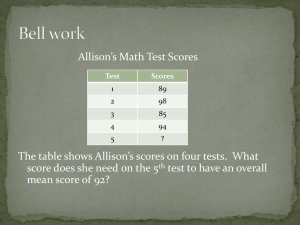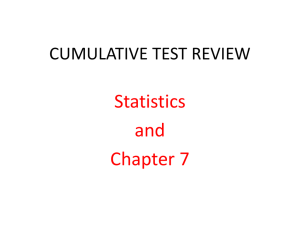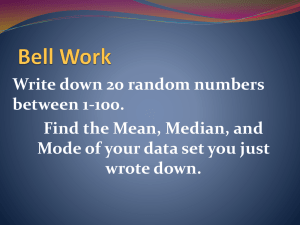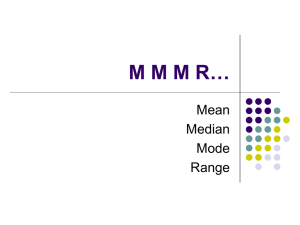Answer Key
advertisement
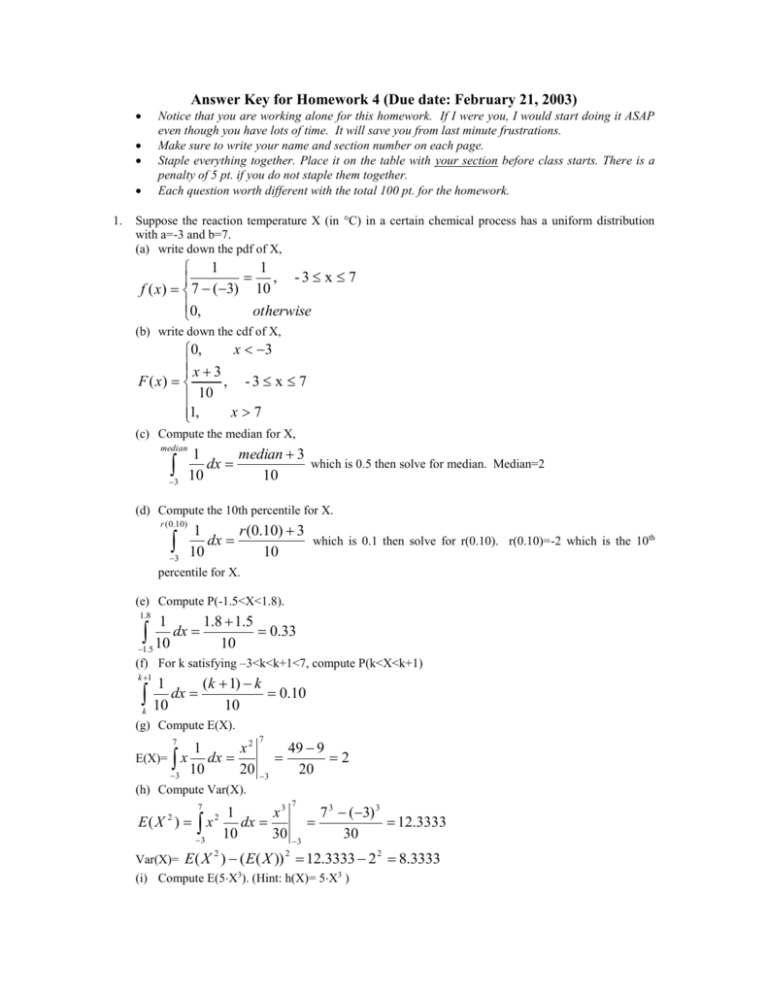
Answer Key for Homework 4 (Due date: February 21, 2003) Notice that you are working alone for this homework. If I were you, I would start doing it ASAP even though you have lots of time. It will save you from last minute frustrations. Make sure to write your name and section number on each page. Staple everything together. Place it on the table with your section before class starts. There is a penalty of 5 pt. if you do not staple them together. Each question worth different with the total 100 pt. for the homework. 1. Suppose the reaction temperature X (in C) in a certain chemical process has a uniform distribution with a=-3 and b=7. (a) write down the pdf of X, 1 1 , -3 x 7 f ( x) 7 (3) 10 0, otherwise (b) write down the cdf of X, x 3 0, x 3 F ( x) , -3 x 7 10 x7 1, (c) Compute the median for X, median 3 1 median 3 which is 0.5 then solve for median. Median=2 dx 10 10 (d) Compute the 10th percentile for X. r ( 0.10) 3 1 r (0.10) 3 which is 0.1 then solve for r(0.10). r(0.10)=-2 which is the 10th dx 10 10 percentile for X. (e) Compute P(-1.5<X<1.8). 1.8 1 10 dx 1.5 1.8 1.5 0.33 10 (f) For k satisfying –3<k<k+1<7, compute P(k<X<k+1) k 1 1 10 dx k (k 1) k 0.10 10 (g) Compute E(X). 7 1 x2 x dx E(X)= 10 20 3 7 49 9 2 20 3 (h) Compute Var(X). 7 1 x3 E( X ) x dx 10 30 3 2 7 2 3 7 3 (3) 3 12.3333 30 Var(X)= E ( X ) ( E ( X )) 12.3333 2 (i) Compute E(5X3). (Hint: h(X)= 5X3 ) 2 2 2 8.3333 7 x4 7 4 (3) 4 1 290 E (5 X ) 5 x dx 5 5 10 40 40 3 3 7 3 2. 3 Exercise 4.12 (a) P(X<0)=F(0)= 1 3 03 4(0) 0.5 2 32 3 1 (b) P(-1 < X < 1)=F(1)-F(-1)= 2 1 (c) P(X > 0.5)=1-F(0.5)=1- 2 (d) F’(x)= 3 13 1 3 (1) 3 4(1) 4(1) =0.6875 32 3 2 32 3 3 0 .5 3 4(0.5) =0.3164 32 3 3 3x 2 4 0.09375(4 x 2 ) 32 3 (e) Since P(X<0)=P(X0)=0.5 then median=0 using part (a). Alternative method is F(median)=0.5 then solve for median. 3. In each case, determine the value of the constant c that makes the probability statement correct. (a) P(0 Z c)=0.4649 then c=1.81 (b) P(Z c)=0.0022 then c=2.85 (c) P(|Z| c)=0.0044 then c=2.85 4. Find the following percentiles for the standard normal distribution. (a) 85th P(Zz)=0.85 then the 85th percentile of Z is z=1.04 (b) 15th P(Zz)=0.15 then the 15th percentile of Z is z=-1.04 5. Let Z be the standard normal random variable and calculate the following probabilities. (a) P(0 Z 1.9)=0.4713 (b) P(Z 1.9)=0.0287 (c) P(|Z| 1.9)=0.9426 6. Exercise 4.35 (a) X~ N(25, 52) P(X x*)= 0.91 = P(Z (x*-25)/5) then (x*-25)/5=1.34 and x*=31.7 (b) P(X x*)= 0.06 = P(Z (x*-25)/5) then (x*-25)/5=-1.555 and x*=17.225 (c) X~ N(3, 0.152) P(X > x*)= 0.10 is the same as P(X x*)=0.90= P(Z (x*-3)/0.15) then (x*-3)/0.15=1.28 and x*=3.192 7. Exercise 4.39 10.256 10.256 1.28 0.1 . Using the table 9.671 9.671 1.645 P(X<9.671)=0.05 then P Z 0.05 . Using the table P(X>10.256)=0.10 then P Z We have two equations and two unknowns and . If we solve for the unknowns, =10 and =0.2. 8. Exercise 4.40 (a) P(|X- |1.5)=P(-1.5Z1.5)=0.8664 (b) P(|X- |2.5)=1-P(-2.5Z2.5)=0.0124 9. Exercise 4.49 (notice that this is normal approximation to the binomial) p: P(all drivers in a certain state regularly wear a seatbelt) =0.40 n=500 drivers selected X: number of drivers regularly wear seatbelt ~ Binomial(n=500, p=0.40) E(X)=np=500(0.40)=200 Var(X)=np(1-p)=500(0.40)(0.60)=120 then np(1 p) =10.9545 (a) P( 180 X 230) = P(X 230) - P(X <180) = P(X 230)-P(X 179) 230 0.5 200 179 0.5 200 P z P z =P(Z2.78)- P(Z-1.87) 10.9545 10.9545 = 0.9973 - 0.0307 =0.9666 174 0.5 200 = P(Z -2.33) = 0.0099 10.9545 149 0 . 5 200 P(X<150) = P(X 149)= P z = P(Z -4.61) = 0 10.9545 (b) P(X<175) = P(X 174)= P z 10. Exercise 4.53 (a)(b) (a) (6) (6 1)! = 5! = 120 (b) (5 / 2) (3 / 2)(3 / 2) (3 / 2)(1 / 2)(1 / 2) 3 = 1.3293 4 11. Exercise 4.55 X:time taken to mow the lawn ~Gamma (=2,=1/2) then X/ ~Gamma (=2,=1) (a) P(X 1)=P(X/ 2) = 0.594 (b) P(X 2)=P(X/ 4) =1-P(X/ < 4) = 1 - 0.908 = 0.092 (c) P(0.5 X 1.5 ) = P(X/ 3) - P(X/ < 1) =0.801 - 0.264 = 0.537 12. Exercise 4.92 X: the breakdown voltage ~N(=40, 2=1.52) (a) P(39X42)= P(-0.67Z1.33)=0.9082-0.2514=0.6568 (b) P(X>x*)=0.15 then x*=?. First transform it to z and then look at the table. x*=40+1.04(1.5)=41.56 (c) P(at least one exceeds 42)=1-P(all four does not exceed 42)=1-(P(X42))4=1-(P(Z1.33))4 =1-(0.9082)4=0.3197 13. Exercise 4.98. Additional to the question, (d) what is the value of the median path length? X ~ Exponential (=1/=1/0.93) then f(x)= 0.93 e P(Xx)= 1 e P(X>x)= e 0.93 x 0.93 x P(a < X < b) = e 0.93a -e 0.93b 0.93 x , x>0. (a) If =0.93 then E(X)=1/0.93=1.0753 and also the standard deviation is 1.0753 P(X>3)= e 0.93( 3 ) (b) P(X>x)= e =0.0614 and P(1 < X < 3) = e 0.93 x 0.93(1) -e 0.93( 3 ) =0.10 then x=2.4759 (c) P(X>median)= e 0.93( median) =0.5 then median=0.7453 =0.3331

